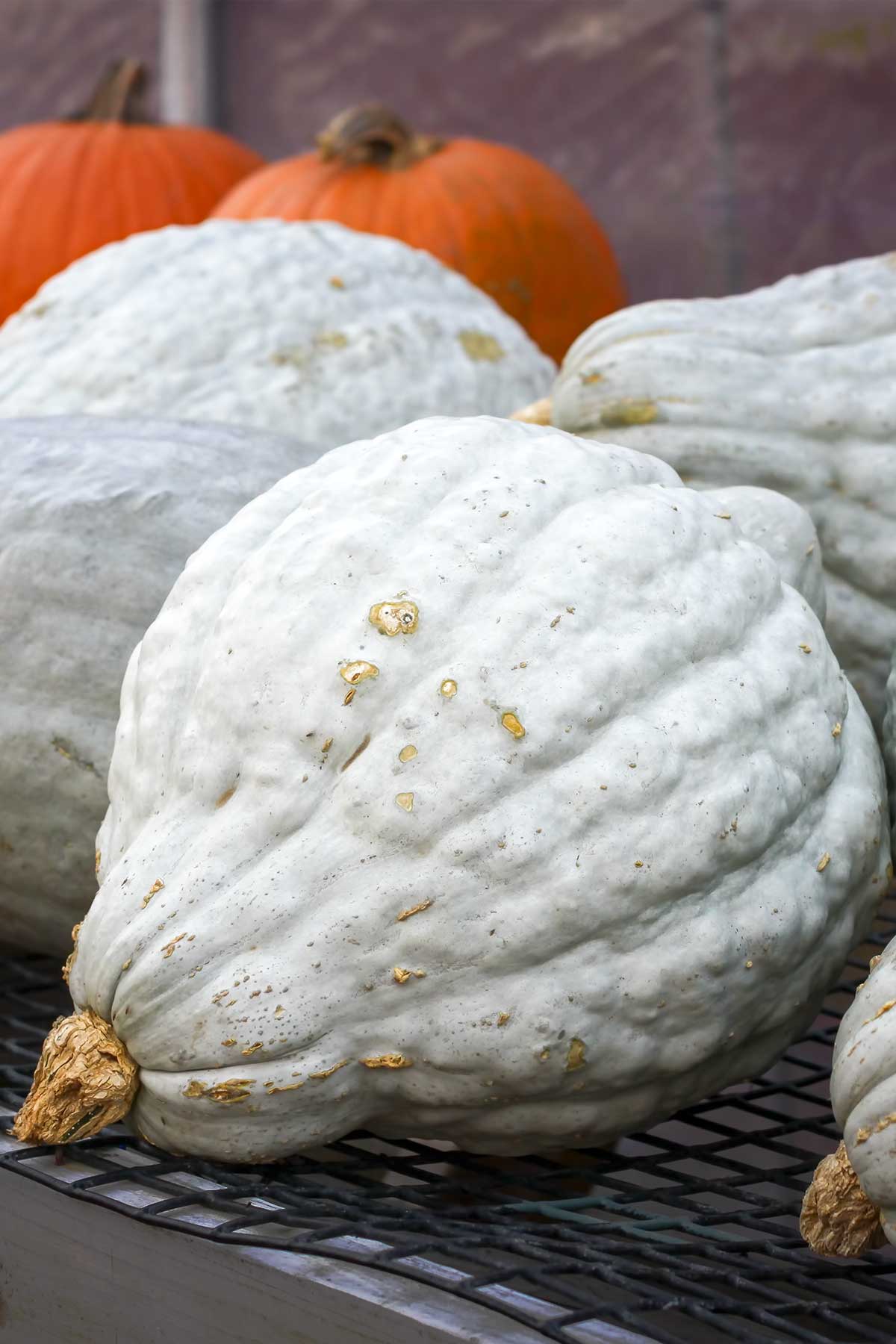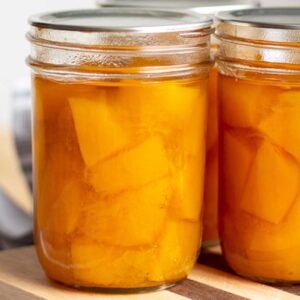Blue Hubbard Squash – Ways to Use & Preserve
Hey friends! If you’ve ever wrestled a Blue Hubbard squash into submission, you know it’s basically a boulder disguised as a vegetable—ginormous, tough-skinned, and full of sweet, creamy potential. But here’s the good news: this beast is a total game-changer for fall baking, soups, and more. Today, I’m updating my old fave guide on preserving it, with all the tried-and-true methods for freezing and pressure canning. (Pro tip: This works for any winter squash or pumpkin—yep, they’re basically cousins.)A quick flashback: A few years back, I tried pressure canning pumpkins in our tiny RV while full-timing with our family of six. Spoiler: It turned the place into a sauna from hell. Fast-forward to now, with a proper kitchen setup? Bliss. No more sweat equity required.

Squash vs. Pumpkin: The Hilarious History Lesson You Didn’t Know You Needed
Ever wonder why your “pumpkin” pie tastes suspiciously like… squash? Blame history! Pumpkins are North American natives, but they’re kinda bland and watery. Enter winter squash like our Blue Hubbard hero: more flesh, natural sweetness, and a silkier puree that makes the best custard fillings.
I geeked out hard over Stella Parks’ BraveTart, still my desert-island cookbook—grab it for the stories alone). On page 164, she drops this gem from 1881’s Arthur’s Home Magazine:
“Squash is preferable to pumpkin and should always be used instead…but call it pumpkin pie—that sounds better.”
And don’t get me started on poet Emily Leland in 1890:
“When I want to make the richest, creamiest, and altogether loveliest pumpkin pies, I use squash. But as squash pies are never celebrated in rhyme…I permit them to be called Pumpkin.”
Mind. Blown. In 1938, the FDA even blurred the lines legally—no distinction between “squash” and “pumpkin.” So, that canned “pumpkin” in stores? Straight-up squash, folks. Use Blue Hubbard (or Buttercup) anywhere you’d use pumpkin: my pumpkin pie cheesecake, pumpkin spice bread, pumpkin bars with cream cheese frosting, or fluffy pumpkin pancakes. Game on!
Now, let’s get to preserving. Safety first: Always follow USDA guidelines for low-acid foods like squash. Use a tested pressure canner (not water bath), and check your elevation for PSI adjustments.
How to Freeze Blue Hubbard Squash: Easy Puree for Later
Freezing is forgiving—you want that smooth puree for pies and beyond. The tough skin? Yeah, it’s a workout, so sharpen your knife and go slow. Aim for fully cooked squash that mashes easily.
Cooking Options (Pick Your Vibe):
- Instant Pot: Chunk (seed removed), trivet in pot, 1 cup water. High pressure 5 minutes, quick release. Scoop.
- Roast Whole: Pierce the whole squash 5-6 times with a knife (no explosions, please). Place on a foil-lined baking sheet with 1/2 inch water. Roast at 400°F for 45-60 minutes until fork-tender. Cool, halve, seed, and scoop.
- Roast Halved: Halve, seed, and place cut-side down in a pan with 1 inch water. Pierce skin. Roast at 400°F for 30-40 minutes until soft. Cool and scoop.
- Slow Cooker: Halve, seed, and chunk into 4-6 pieces. Add to cooker with 1/2-1 cup water. High for 3-4 hours. Scoop when cool.
Freezing Steps:
- Puree the cooked flesh in a food processor or blender until silky (no lumps!).
- Portion into recipe-sized amounts: 1-2 cups per muffin tin well, silicone molds, or freezer bags (flatten for space-saving and easier thawing).
- Label with date and volume/weight (e.g., “2 cups puree, 10/6/25”).
- Freeze flat. Good for 12-18 months—thaw in fridge overnight.
Pro yield tip: One medium Blue Hubbard (8-10 lbs) gives about 8-10 cups puree.

How to Pressure Can Blue Hubbard Squash (Hot Pack)
Canning keeps it chunked for versatility (soups, stews, or mashing later). Hot-pack only—don’t puree, or it gets mushy and unsafe.
Pressure Canned Blue Hubbard Squash
Print Recipe
EQUIPMENT (affiliate links)
- canning jars 7 quart or 14 pint jars
- jar lifter tongs
- canning funnel
- non-metallic bubble remover (plastic knife, wood skewer, or chopstick)
- clean cloths for wiping rims
- large pot for boiling if using boil method for par-cooking or
Ingredients
- 20-25 lbs Blue Hubbard squash
- Boiling water enough to cover jars
Instructions
- Prepare the Squash: Wash squash. Cut into large chunks (remove seeds and tough strings). Peel (or par-cook to peel—see options below). Cube into 1-inch pieces.
- Cook the Chunks (Hot Pack Method – Choose One Method Below):
- – Boil Method (Recommended): In a large pot, cover large chunks with warm water. Bring to boil; simmer 2 minutes until heated through but firm (not soft). Drain.
- – Instant Pot Method: Chunk squash on trivet with 1 cup water. High pressure 1 minute; quick release. Drain and cool slightly.
- Prepare Canner: Fill pressure canner with 2-3 inches water (per your canner's manual). Heat to simmer. Sterilize jars in boiling water or dishwasher.
- Pack Jars: Pack hot chunks loosely into hot jars, leaving 1-inch headspace. Ladle boiling water over, maintaining 1-inch headspace. Remove air bubbles with a non-metallic tool (like a chopstick). Wipe rims clean. Apply lids and bands fingertip-tight.
- Process: For dial-gauge canner: 11 PSI (adjust for altitude). For weighted: 10 PSI. Pints: 55 minutes. Quarts: 90 minutes. Start timing once pressure is reached.
- Cool Down: Turn off heat. Let pressure drop naturally (no quick release or jiggling the weight)—this takes 30-60+ minutes until the gauge reads zero and locks disengage easily. Do not force-cool. Once at zero, you can leave the lid in place and let it sit undisturbed in the canner for an additional hour (helps prevent siphoning/spillage). Then, carefully lift jars out using a jar lifter and place on a towel-lined surface to cool 12-24 hours.
- Store: Check seals after cooling (lids should not flex). Remove bands, wipe jars, label ("Blue Hubbard Squash, 9/2023"), and store in cool, dark place. Use within 1 year for best quality. Refrigerate after opening.
Notes
- Always test your canner gauge annually. If seals fail, refrigerate and use within a week.
- Drafty spots or cold counters can shock jars—towel to the rescue!
- Safety first: Consult USDA Complete Guide to Home Canning for altitude adjustments.
Video
There you have it—shelf-stable squash that’ll make your future self thank you. (Safety reminder: Low-acid veggies must be pressure canned; botulism isn’t cute.)
So, spill: Do you secretly swap squash into your “pumpkin” pies? What’s your go-to winter squash for that creamy magic? Drop your faves below!
Until next time, happy canning!
As an Amazon Associate, I earn from qualifying purchases at no extra cost to you. Thank you for your support!

No, you cannot *safely* use canned pumpkin, squash, hubbard squash, or any squash.
As you well know.
This is sickening. To think one knows more than the experts who have tested canned foods for decades in laboratory conditions, and after food-poisoning incidents, is sick.
Thank you for your comment.
While I understand your concern, I wanted to provide links to reputable canning instructions, which say the contrary. There is clear guidance that pressure canning squash, pumpkin, etc. is safe if done correctly.
Blessings!
pureed pumpkin/squash isn’t safe to can because of the density. My canning book that came with my pressure canner lists pumpkin and hubbarb squash with direction as stated here.
Wrong.
https://nchfp.uga.edu/how/can/canning-vegetables-and-vegetable-products/pumpkins-and-winter-squash-cubed/#:~:text=Quantity:%20An%20average%20of%2016,a%20dial%2Dgauge%20pressure%20canner.